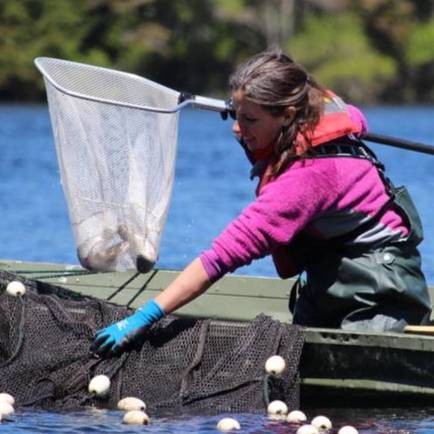Damselflies Study Sheds More Light on Climate Change
Michigan State University biologists have studied damselflies – which resemble dragonflies and are abundant as both predator and prey in wetlands – to understand what happens throughout their lifecycle from nymph to winged insect, along with what they eat when summers grow warmer and longer.
Their work in this week’s Proceedings of the Royal Society B has a twist – combining seasons of observational and experimental work in the field and lab with input from a theoretical ecologist, a mathematician by training with supersized modeling credentials.
The results: A more realistic look at what a hot summer can bring to a nearby pond, and new respect for the blinding speed global warming is bringing.
“We are seeing the pace of climate change is much more rapid than organisms have endured in their evolutionary experience,” said Phoebe Zarnetske, associate professor in the Department of Integrative Biology and study co-author. “That rapid pace is going to be even more of an issue with the increase in extreme events like heat waves.”
The work in “Life-history responses to temperature and seasonality mediate ectotherm consumer–resource dynamics under climate warming,” finds that inserting the right level of data gleaned from field experiences, specifically the effects of seasonal changes in temperature on consumer lifecycles, creates a more robust predator-prey simulation model.
The work differs from findings of similar models with less biological realism that predicted warming trends would doom predators. They see Michigan damselflies surviving climate warming by shifting into a lifecycle similar to their southern relatives – squeaking out two lifecycles in a season rather than one.
The work developed when first author Laura Twardochleb was a Ph.D. student in Zarnetske’s lab. She had spent time observing damselflies’ one-year lifecycle in Michigan. They emerge as adults from ponds in the spring. They mate, reproduce and the juveniles grow over a year in the pond by eating zooplankton. They make good study subjects, she said, because they thrive both outside and in the laboratory.
Twardochleb, now with the California State Water Resources Control Board, was part of MSU’s Ecology, Evolution, and Behavior (EEB) Program and as a part of that took a class by Chris Klausmeier, MSU Research Foundation Professor of plant biology and integrative biology and a W.K. Kellogg Biological Station faculty member.
Twardochleb saw that early models projecting how warming climates would affect ectothermic predators were significantly simpler than the nature she was observing. For one thing, the models didn’t allow for the north’s change of seasons. The models also weren’t keeping track of a predator’s size and growth rate and changes in their lifecycle with warming.
Meanwhile, Klausmeier, a theoretical ecologist, was recognizing the special sauce an experimentalist brings when creating mathematical models that take assumptions about how organisms behave, grow, birth, die.
“I can make up any model I want unconstrained by reality,” Klausmeier said. “But that’s a little dangerous because of course you want something related to the real world. When you join with an experimentalist you can bring not just the experimental results and parameters, but also bring the deep natural history and knowledge to the system to know the key variables and constraints.”
The work, factoring in a warmer, but still seasonal climate shows how the damselflies can grow and breed more quickly. Creating a model that only allowed the virtual damselflies to live a one-year lifecycle in a warmer world, they burned out and died. Extinction was on the horizon.
But allow the bugs the option of bringing two generations into a season, and thriving was a possibility. “A lot of models said [predators] were going to starve,” Twardochleb said. “That’s what’s exciting – that we can make models more realistic.”
Twardochleb said the work is good groundwork to understand how other species will respond to a warmer world, particularly species such as mosquitoes which are both nuisances and potentially carry diseases.
Zarnetske added that the continual challenge will be beyond the idea that different species will be adapting to a new world. Climate change is outpacing that kind of evolution in an unprecedented way. And the weather extremes – heat waves, droughts, floods – are a whole variable.
“That’s our next step,” Zarnetske said. “Unpredictability is hard.”



